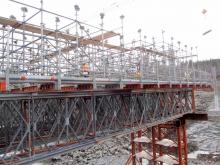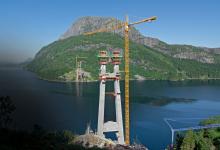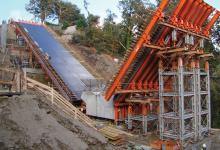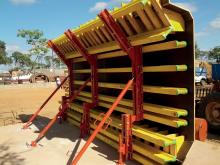Advanced bridge formwork solutions are allowing contractors to complete vital major highway infrastructure projects covering Norway, Sweden, Estonia and Poland. Guy Woodford reports
Building the Labbdalen bridges in Norway is a key feature of the E6 highway improvement programme. Main project contractor HÆHRE tasked RMD Kwikform and Teknikk with supplying a complete formwork and shoring solution that could tackle the challenging Norwegian terrain, whilst preserving the environment.
Situated two hours
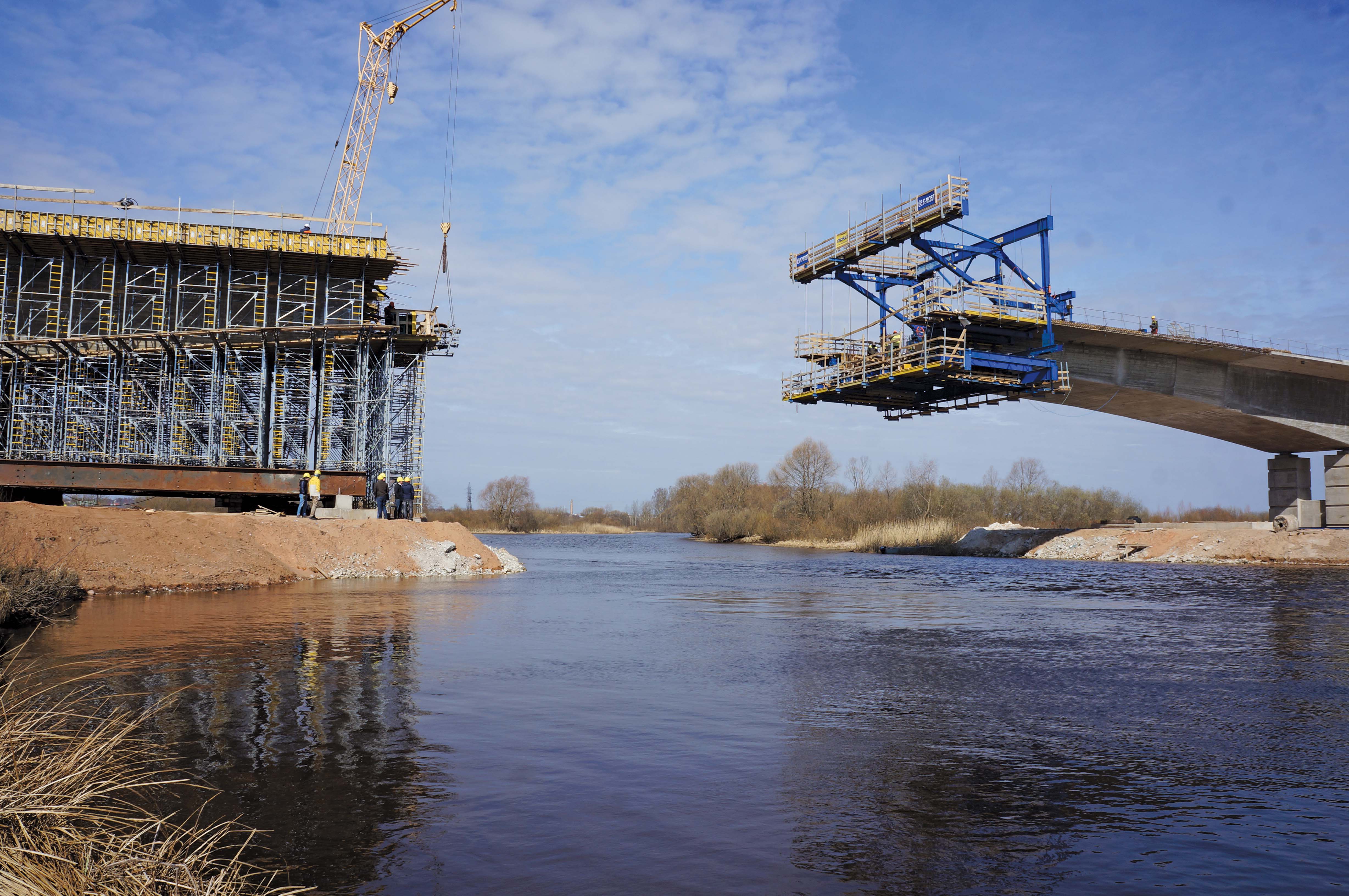
The Tartu Bridge over the Emajõgi is being constructed with load-bearing towers Staxo 100 and a cantilever forming traveller
Advanced bridge formwork solutions are allowing contractors to complete vital major highway infrastructure projects covering Norway, Sweden, Estonia and Poland. Guy Woodford reports
Building the Labbdalen bridges in Norway is a key feature of the E6 highway improvement programme. Main project contractor HÆHRE tasked319 RMD Kwikform and Teknikk with supplying a complete formwork and shoring solution that could tackle the challenging Norwegian terrain, whilst preserving the environment.
Situated two hours north of Norway’s capital Oslo, the 73m long East and 78m long West Labbdalen bridges are two of a number of new structures for the government funded improvement works to the key European highway. Linking Norway with Sweden, the 3,140km long E6 is the main north-south road in Norway and the west coast of Sweden, running from the southern tip of Sweden, at Trelleborg, into Norway and through almost all of the country north to Finnmark.
The twin deck post-tension Labbdalen Bridge has been designed with a central span of 28.4m, with each bridge deck being 10.5m wide and 1.1m deep. In order for the bridge to span the valley where the melting snow from the mountains flows down in to the lake below, the piers had to be skewed at 30°, making its construction increasingly complex. With tunnels bored on one side of the valley, Stone spoil was used to cover a temporary culvert, which was constructed to channel away the melt water, enabling the complex temporary works to be erected onsite.
With the piers already cast in-situ, the levelled out and compacted spoil base provided a perfect platform for the erection of the soffit support. Here RMD Kwikform’s Rapidshor steel shoring was built into a towered birdcage up to 11m tall and interlaced as soffit support to steel primary and timber secondary beams. The design for the Rapidshor shoring was critical to the overall project as not only did the solution have to support the bridge decks that sloped in two directions, it also had to provide adequate access to the rest of the site.
In order to achieve this, RMD Kwikform engineers in the UK used a 3D model of the bridge decks provided by contractor HÆHRE to model the Rapidshor shoring solution.
Then utilising RMD Kwikform’s 3D Locus programme, a design was created by RMD Kwikform’s engineers for the 28.4m Rapidshor centre span of the each bridge. By using the Locus 3D programme this allowed the design of the Rapidshor to be plotted accurately providing the leg make up and leg extensions in each grid. The Locus programme took in to account the geometry and cross fall of the bridge deck providing exact positioning and quantities of the Rapidshor support system.
Of the approach to the formwork challenge, RMD Kwikform engineer Adam Fixter said, “By taking the 3D model of the bridge and putting it into our customised suite of CAD software, we were able to create our own 3D model of the shoring solution. This allowed us to work with our distributor Teknikk and HÆHRE to create a workable solution for the site, eliminating clashes, whilst creating plans, sections and elevations for the site team. This process gave them all the information they needed to correctly erect the equipment.
“To support the main deck construction, we opted for a ten by nine leg 1.8m braced Rapidshor setup in the middle of the valley, with three and five 1.5m leg wide braced arrangements at either end, to support the heavier loads at the edges of the bridge deck. This arrangement allowed for two main 1.2m walkways in-between each Rapidshor birdcage arrangement. In addition to supporting layout arrangements, the model also meant we could provide accurate equipment quantities, making sure our logistics team could dispatch the right amount of Rapidshor to site.”
With the main soffit support for the bridge decks using Rapidshor, the next challenge for the formwork and shoring design to overcome, were the rock slopes under the side spans of the bridge decks. Due to a combination of the steepness and stability of the rock on the slopes and the desire to minimise the environmental impact of the project, the team was unable to use Rapidshor for this phase of works.
Teknikk engineering manager Morten Hernes added, “For the side spans we had three main issues: cost, time and safety. We didn’t want to add cost or time to the project by having special steel items fabricated, and we knew we needed to have a safe solution to the issue of dealing with loose rock. We therefore opted to completely span over these obstacles with RMD Kwikform’s R700 Clear Span Truss System.
They were designed to form truss arrangements that were further stiffened using reinforcing chords to minimise elastic defection under load. Having used the R700 product before on a similar project, we knew it could be made up in sections and twinned together to ease the erection onsite. This arrangement was flexible enough to cover the varying spans, reaching up to a maximum of 15.6m.
“Having taken this option, we were then faced with the challenge of how to support the weight of each of the five truss pairs, coupled with the extra loading of the side sections of the bridge deck. By creating temporary foundations at the top of the rock slope, we only needed to come up with a solution to support the trusses from the new valley floor. This was achieved by creating a support system using RMD Kwikform’s heavy-duty 1000kN Megashor shoring.”
Made up of eight Megashor legs, supported with bracing members and connected together with steel Superslim Soldiers, each of the four 7.62m Megashor towers used for the project were fixed using Megashor Brace Plates on to steel plates on the valley floor then adjusted with the Megashor Screw Jacks.
The RMD Kwikform engineering team was then able to supply contractor HÆHRE with the dimensions required to pre-drill the header beams.
The HEB 260 secondary header beams were seated on the HEB 500 primary beams, providing the support for each of the R700 Trusses at the valley end of the truss section. These beams were then in turn mounted and fixed onto each of the four Megashor towers.
With the twin bridge decks cast 9m apart, each Megashor tower arrangement had to be sited according to the varying rock slopes, a process which also determined the size of each girder. Fixter said, “With a simple erection process, the key challenge was how to remove the girders, once the bridge decks had been cast. This was where the steel header beam arrangement came into its own, as once the bridge deck was struck and post tensioned, the secondary beam was disconnected from the primary and with a little bit of lubrication, the girders could be slid out of each side of the deck. This was made possible thanks to the primary beams being long enough to reach past either side of the deck, allowing the R700 trusses to be safely removed and lowered ready for disassembly in the lay down area.”
With all of the formwork and shoring designed to withstand wind pressure of 1.1kN/m2 and temperatures as low as -20°C , the solutions devised by RMD Kwikform and Teknikk will ensure HÆHRE a safe and swift project delivery. The bridge and new section of the E6 Highway is due to open in November 2014.
The steadily increasing volume of traffic in and around Tartu, Estonia’s second largest city with a population of around 100,000, has led to the ongoing creation of a new road network aimed at keeping motorists moving.
The large-scale road-building project has faced a number of topographical hurdles, with the undoubted biggest being the construction of a road bridge across Emajõgi river. To overcome this key hurdle, lead contractor K-MOST AS brought in Austrian formwork experts203 Doka, a company it has cooperated with over many years.
The new-build Tartu bridge will be 400m long and 15.5m wide. Most of its formworking can be done on compacted riverbank subsoil with Doka’s Staxo 100 load-bearing towers. However, the Emajõgi river cannot be dammed or even diverted, so shoring over the full span is not an option. As a result, a high-performing Doka cantilever forming traveller made its Baltic region debut to throw the 55m middle section of the bridge across the water. Doka formwork instructors were recently in attendance to coordinate the cantilever forming traveller setup and familiarise the site crew with its application procedures. Each concrete section within the middle section is 5.1m long, and a formwork instructor was on site for the cantilever forming traveller's first advance, to make sure that everything went smoothly. After the second concreting section was successfully placed, the site crew was able to take charge of the cantilever forming traveller advancing procedure without further assistance.
The cantilever forming traveller is on site for only a very short time, so the project owner benefits from the Doka Group's rental model. Instead of being bought outright, the formwork system is simply hired for the duration. That saves costs and stops capital being tied up unnecessarily. Usage of the formwork system is billed by the day and the equipment is returned as soon as the job is done.
Doka has a branch in Estonia, so formwork engineers were always on call to answer queries. Moreover, communication in the local language facilitated technical instruction for the entire construction crew. The new Tartu road network project is scheduled for completion by the end of 2015.
Doka is the leading division within the Amstetten, Austria-based Umdasch Group, which last month published its 2013 performance figures showing how the Group had achieved a revenue increase for the third year in a row, principally due to the continuing success of Doka. Sales improved by 3% compared to 2012 to €1.092 billion, representing the second best annual sales figures in the entire 150 years of the Group.
298 PERI’s modular solutions for formwork and scaffolding were used on the new and impressive Vistula bridge near Kwidzyn, northern Poland. Their deployment was said to allow lead contractors 3302 Budimex and 2717 Ferrovial Agroman to comply with a very tight construction schedule for the near €64 million project, mainly without the need of crane and good weather.
Although the Vistula crossing, one of the new accesses to National Road 90, extends to a length of around 12km, its vital elements are the 808m-long main bridge and a trio of foreland bridges. While not all structures were similar, PERI supplied a comprehensive overall solution, focused on its VARIOKIT, RCS and PERI UP modular systems.
PERI’s concept for the main bridge saw the use of self-climbing formwork for the two bridge piers, the superstructure formwork for the hollow box Cross-sections with formwork carriage as well as the falsework for the edge sections. A site bespoke VARIOKIT formwork carriage was used to help form the parapet beams. For the bridge pylons, the TRIO formwork was climbed using mobile RCS rail-guided self-climbing devices.
With its total length of 1,000m, the superstructure of the foreland bridges was carried out using the incremental launching method, assisted by VARIO girder formwork, in 30m casting segments in regular weekly cycles. Furthermore, a protective roof construction based on the LGS lattice girder system was said to make the construction work weather-independent. Additionally, an inside heating system ensured that work continued during the winter and consistently high concrete quality was achieved. PERI said that, when required, the weather protection roof took only a few minutes to open as the roof sections could be moved by hand.
The Vistula is the longest and largest river in Poland, at 1,047km in length, travelling through the country’s capital Warsaw, and also Krakow and Gdansk, on Poland’s north coast. Its watershed (drainage basin) are a covers 194,424km², of which 168,699km² lies within Poland. The remainder is in Belarus and the Ukraine.
Building the Labbdalen bridges in Norway is a key feature of the E6 highway improvement programme. Main project contractor HÆHRE tasked
Situated two hours north of Norway’s capital Oslo, the 73m long East and 78m long West Labbdalen bridges are two of a number of new structures for the government funded improvement works to the key European highway. Linking Norway with Sweden, the 3,140km long E6 is the main north-south road in Norway and the west coast of Sweden, running from the southern tip of Sweden, at Trelleborg, into Norway and through almost all of the country north to Finnmark.
The twin deck post-tension Labbdalen Bridge has been designed with a central span of 28.4m, with each bridge deck being 10.5m wide and 1.1m deep. In order for the bridge to span the valley where the melting snow from the mountains flows down in to the lake below, the piers had to be skewed at 30°, making its construction increasingly complex. With tunnels bored on one side of the valley, Stone spoil was used to cover a temporary culvert, which was constructed to channel away the melt water, enabling the complex temporary works to be erected onsite.
With the piers already cast in-situ, the levelled out and compacted spoil base provided a perfect platform for the erection of the soffit support. Here RMD Kwikform’s Rapidshor steel shoring was built into a towered birdcage up to 11m tall and interlaced as soffit support to steel primary and timber secondary beams. The design for the Rapidshor shoring was critical to the overall project as not only did the solution have to support the bridge decks that sloped in two directions, it also had to provide adequate access to the rest of the site.
In order to achieve this, RMD Kwikform engineers in the UK used a 3D model of the bridge decks provided by contractor HÆHRE to model the Rapidshor shoring solution.
Then utilising RMD Kwikform’s 3D Locus programme, a design was created by RMD Kwikform’s engineers for the 28.4m Rapidshor centre span of the each bridge. By using the Locus 3D programme this allowed the design of the Rapidshor to be plotted accurately providing the leg make up and leg extensions in each grid. The Locus programme took in to account the geometry and cross fall of the bridge deck providing exact positioning and quantities of the Rapidshor support system.
Of the approach to the formwork challenge, RMD Kwikform engineer Adam Fixter said, “By taking the 3D model of the bridge and putting it into our customised suite of CAD software, we were able to create our own 3D model of the shoring solution. This allowed us to work with our distributor Teknikk and HÆHRE to create a workable solution for the site, eliminating clashes, whilst creating plans, sections and elevations for the site team. This process gave them all the information they needed to correctly erect the equipment.
“To support the main deck construction, we opted for a ten by nine leg 1.8m braced Rapidshor setup in the middle of the valley, with three and five 1.5m leg wide braced arrangements at either end, to support the heavier loads at the edges of the bridge deck. This arrangement allowed for two main 1.2m walkways in-between each Rapidshor birdcage arrangement. In addition to supporting layout arrangements, the model also meant we could provide accurate equipment quantities, making sure our logistics team could dispatch the right amount of Rapidshor to site.”
With the main soffit support for the bridge decks using Rapidshor, the next challenge for the formwork and shoring design to overcome, were the rock slopes under the side spans of the bridge decks. Due to a combination of the steepness and stability of the rock on the slopes and the desire to minimise the environmental impact of the project, the team was unable to use Rapidshor for this phase of works.
Teknikk engineering manager Morten Hernes added, “For the side spans we had three main issues: cost, time and safety. We didn’t want to add cost or time to the project by having special steel items fabricated, and we knew we needed to have a safe solution to the issue of dealing with loose rock. We therefore opted to completely span over these obstacles with RMD Kwikform’s R700 Clear Span Truss System.
They were designed to form truss arrangements that were further stiffened using reinforcing chords to minimise elastic defection under load. Having used the R700 product before on a similar project, we knew it could be made up in sections and twinned together to ease the erection onsite. This arrangement was flexible enough to cover the varying spans, reaching up to a maximum of 15.6m.
“Having taken this option, we were then faced with the challenge of how to support the weight of each of the five truss pairs, coupled with the extra loading of the side sections of the bridge deck. By creating temporary foundations at the top of the rock slope, we only needed to come up with a solution to support the trusses from the new valley floor. This was achieved by creating a support system using RMD Kwikform’s heavy-duty 1000kN Megashor shoring.”
Made up of eight Megashor legs, supported with bracing members and connected together with steel Superslim Soldiers, each of the four 7.62m Megashor towers used for the project were fixed using Megashor Brace Plates on to steel plates on the valley floor then adjusted with the Megashor Screw Jacks.
The RMD Kwikform engineering team was then able to supply contractor HÆHRE with the dimensions required to pre-drill the header beams.
The HEB 260 secondary header beams were seated on the HEB 500 primary beams, providing the support for each of the R700 Trusses at the valley end of the truss section. These beams were then in turn mounted and fixed onto each of the four Megashor towers.
With the twin bridge decks cast 9m apart, each Megashor tower arrangement had to be sited according to the varying rock slopes, a process which also determined the size of each girder. Fixter said, “With a simple erection process, the key challenge was how to remove the girders, once the bridge decks had been cast. This was where the steel header beam arrangement came into its own, as once the bridge deck was struck and post tensioned, the secondary beam was disconnected from the primary and with a little bit of lubrication, the girders could be slid out of each side of the deck. This was made possible thanks to the primary beams being long enough to reach past either side of the deck, allowing the R700 trusses to be safely removed and lowered ready for disassembly in the lay down area.”
With all of the formwork and shoring designed to withstand wind pressure of 1.1kN/m2 and temperatures as low as -20°C , the solutions devised by RMD Kwikform and Teknikk will ensure HÆHRE a safe and swift project delivery. The bridge and new section of the E6 Highway is due to open in November 2014.
The steadily increasing volume of traffic in and around Tartu, Estonia’s second largest city with a population of around 100,000, has led to the ongoing creation of a new road network aimed at keeping motorists moving.
The large-scale road-building project has faced a number of topographical hurdles, with the undoubted biggest being the construction of a road bridge across Emajõgi river. To overcome this key hurdle, lead contractor K-MOST AS brought in Austrian formwork experts
The new-build Tartu bridge will be 400m long and 15.5m wide. Most of its formworking can be done on compacted riverbank subsoil with Doka’s Staxo 100 load-bearing towers. However, the Emajõgi river cannot be dammed or even diverted, so shoring over the full span is not an option. As a result, a high-performing Doka cantilever forming traveller made its Baltic region debut to throw the 55m middle section of the bridge across the water. Doka formwork instructors were recently in attendance to coordinate the cantilever forming traveller setup and familiarise the site crew with its application procedures. Each concrete section within the middle section is 5.1m long, and a formwork instructor was on site for the cantilever forming traveller's first advance, to make sure that everything went smoothly. After the second concreting section was successfully placed, the site crew was able to take charge of the cantilever forming traveller advancing procedure without further assistance.
The cantilever forming traveller is on site for only a very short time, so the project owner benefits from the Doka Group's rental model. Instead of being bought outright, the formwork system is simply hired for the duration. That saves costs and stops capital being tied up unnecessarily. Usage of the formwork system is billed by the day and the equipment is returned as soon as the job is done.
Doka has a branch in Estonia, so formwork engineers were always on call to answer queries. Moreover, communication in the local language facilitated technical instruction for the entire construction crew. The new Tartu road network project is scheduled for completion by the end of 2015.
Doka is the leading division within the Amstetten, Austria-based Umdasch Group, which last month published its 2013 performance figures showing how the Group had achieved a revenue increase for the third year in a row, principally due to the continuing success of Doka. Sales improved by 3% compared to 2012 to €1.092 billion, representing the second best annual sales figures in the entire 150 years of the Group.
Although the Vistula crossing, one of the new accesses to National Road 90, extends to a length of around 12km, its vital elements are the 808m-long main bridge and a trio of foreland bridges. While not all structures were similar, PERI supplied a comprehensive overall solution, focused on its VARIOKIT, RCS and PERI UP modular systems.
PERI’s concept for the main bridge saw the use of self-climbing formwork for the two bridge piers, the superstructure formwork for the hollow box Cross-sections with formwork carriage as well as the falsework for the edge sections. A site bespoke VARIOKIT formwork carriage was used to help form the parapet beams. For the bridge pylons, the TRIO formwork was climbed using mobile RCS rail-guided self-climbing devices.
With its total length of 1,000m, the superstructure of the foreland bridges was carried out using the incremental launching method, assisted by VARIO girder formwork, in 30m casting segments in regular weekly cycles. Furthermore, a protective roof construction based on the LGS lattice girder system was said to make the construction work weather-independent. Additionally, an inside heating system ensured that work continued during the winter and consistently high concrete quality was achieved. PERI said that, when required, the weather protection roof took only a few minutes to open as the roof sections could be moved by hand.
The Vistula is the longest and largest river in Poland, at 1,047km in length, travelling through the country’s capital Warsaw, and also Krakow and Gdansk, on Poland’s north coast. Its watershed (drainage basin) are a covers 194,424km², of which 168,699km² lies within Poland. The remainder is in Belarus and the Ukraine.

